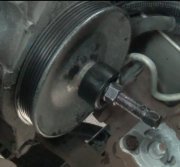A brake pull can be caused by a brake balance problem, shifting alignment due to a loose or worn part, or a tire pull. Tire pulls don't change directions so we can forget about that. Usually the alignment doesn't change two different ways under the stress of braking. The rack and pinion steering gear can be loose but that will shift at some point when you hit bumps in the road regardless of braking or not.
The biggest clue is the problem is gone after that initial brake application. Look for something that is causing the brakes to apply unevenly. The two most common causes are sloppy wheel bearings and sticking or worn caliper mounts. A sloppy bearing lets the rotor wobble and that pushes the piston back into the caliper. That takes a while and many bumps in the road to occur. At the next pedal application one caliper will apply before the other one and that can cause a pull. Since it takes time for the piston to get bumped in again, the two sides will apply evenly after that.
The piston only pushes one pad into the rotor. The reaction forces the caliper away which pulls the outer pad into the rotor. That assumes the caliper can slide freely. If the mounting pins have rust pits the assembly must be replaced. If they're just sticking due to dirt and gunk, they can be cleaned with brake parts cleaner, then lubricated with high-temperature brake grease that contains molybdenum disulphide. "Rusty Lube" is one trade name but there are many others. Auto parts stores have many brands.
One thing all of these brake problems have in common is they will cause the brake pedal to go down further than normal when that problem occurs but it may be hard to notice. A less common problem can occur on cars with removable cross members that the lower control arms are bolted to. This is a real big problem with GM front-wheel-drive cars but it can happen to some other brands. If that cross member is unbolted, then reattached off to one side by as little as 1/8", that moves both control arms and ball joints to one side and will tip both tires. During an alignment one of the three basic angles, "camber" will be found to be wrong and unequal on both sides. Most cars have a means of adjusting camber but that does not address the underlying unequal "steering axis inclination", (SAI). That is a secondary alignment angle that is rarely looked at unless the mechanic is looking for the cause of an elusive problem or checking the results of crash damage repair. Unequal SAI can cause intermittent brake pulls but the main complaint is darting in either direction when hitting bumps in the road. Handling will be very miserable. This probably doesn't apply to your car since the problem only occurs during braking and only after not using the brakes for a while, but it should not be overlooked. The first clue is the brake pedal will not go lower than normal. SAI is measured automatically by all alignment computers. A typical value for SAI is around 26 to 32 degrees. No spec is given. All that is critical is both sides must be exactly the same within 0.2 degrees. If it is not, that must be corrected, then camber must be readjusted.
Thursday, March 21st, 2013 AT 6:51 AM


